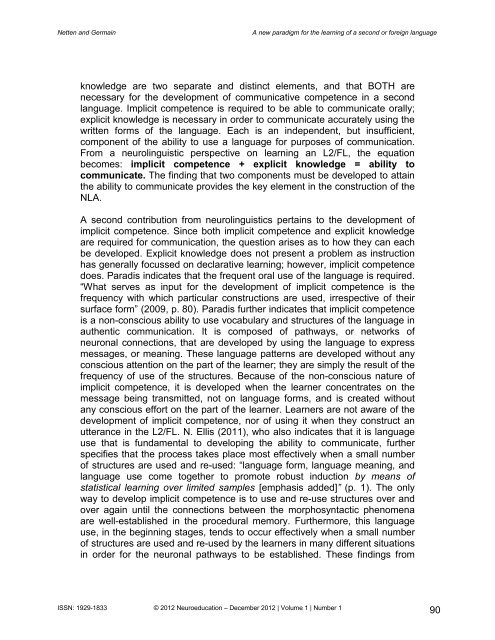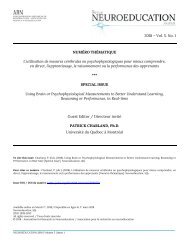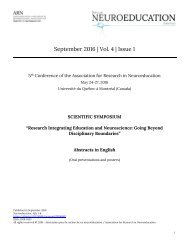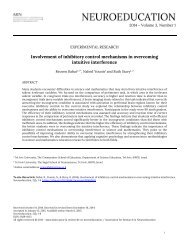Neuroeducation_2012_vol-1_no-1_full
Neuroeducation journal - Volume 1, Issue 1 (2012) - 144 pages
Neuroeducation journal - Volume 1, Issue 1 (2012) - 144 pages
Create successful ePaper yourself
Turn your PDF publications into a flip-book with our unique Google optimized e-Paper software.
Netten and Germain<br />
A new paradigm for the learning of a second or foreign language<br />
k<strong>no</strong>wledge are two separate and distinct elements, and that BOTH are<br />
necessary for the development of communicative competence in a second<br />
language. Implicit competence is required to be able to communicate orally;<br />
explicit k<strong>no</strong>wledge is necessary in order to communicate accurately using the<br />
written forms of the language. Each is an independent, but insufficient,<br />
component of the ability to use a language for purposes of communication.<br />
From a neurolinguistic perspective on learning an L2/FL, the equation<br />
becomes: implicit competence + explicit k<strong>no</strong>wledge = ability to<br />
communicate. The finding that two components must be developed to attain<br />
the ability to communicate provides the key element in the construction of the<br />
NLA.<br />
A second contribution from neurolinguistics pertains to the development of<br />
implicit competence. Since both implicit competence and explicit k<strong>no</strong>wledge<br />
are required for communication, the question arises as to how they can each<br />
be developed. Explicit k<strong>no</strong>wledge does <strong>no</strong>t present a problem as instruction<br />
has generally focussed on declarative learning; however, implicit competence<br />
does. Paradis indicates that the frequent oral use of the language is required.<br />
“What serves as input for the development of implicit competence is the<br />
frequency with which particular constructions are used, irrespective of their<br />
surface form” (2009, p. 80). Paradis further indicates that implicit competence<br />
is a <strong>no</strong>n-conscious ability to use vocabulary and structures of the language in<br />
authentic communication. It is composed of pathways, or networks of<br />
neuronal connections, that are developed by using the language to express<br />
messages, or meaning. These language patterns are developed without any<br />
conscious attention on the part of the learner; they are simply the result of the<br />
frequency of use of the structures. Because of the <strong>no</strong>n-conscious nature of<br />
implicit competence, it is developed when the learner concentrates on the<br />
message being transmitted, <strong>no</strong>t on language forms, and is created without<br />
any conscious effort on the part of the learner. Learners are <strong>no</strong>t aware of the<br />
development of implicit competence, <strong>no</strong>r of using it when they construct an<br />
utterance in the L2/FL. N. Ellis (2011), who also indicates that it is language<br />
use that is fundamental to developing the ability to communicate, further<br />
specifies that the process takes place most effectively when a small number<br />
of structures are used and re-used: “language form, language meaning, and<br />
language use come together to promote robust induction by means of<br />
statistical learning over limited samples [emphasis added]” (p. 1). The only<br />
way to develop implicit competence is to use and re-use structures over and<br />
over again until the connections between the morphosyntactic phe<strong>no</strong>mena<br />
are well-established in the procedural memory. Furthermore, this language<br />
use, in the beginning stages, tends to occur effectively when a small number<br />
of structures are used and re-used by the learners in many different situations<br />
in order for the neuronal pathways to be established. These findings from<br />
ISSN: 1929-1833 © <strong>2012</strong> <strong>Neuroeducation</strong> – December <strong>2012</strong> | Volume 1 | Number 1<br />
90








